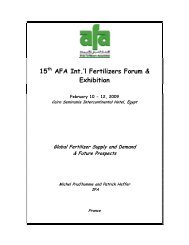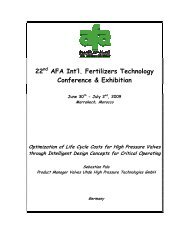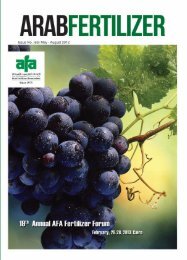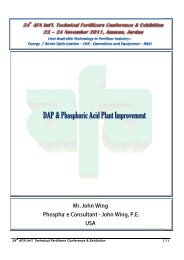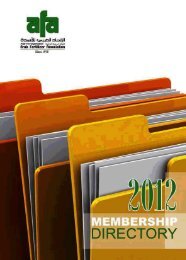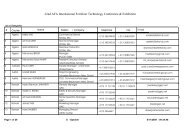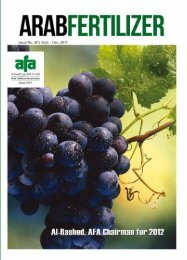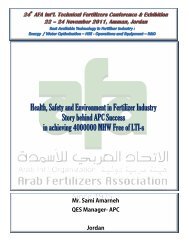120109123543_s3_4.pdf
120109123543_s3_4.pdf
120109123543_s3_4.pdf
- TAGS
- afa.com.eg
You also want an ePaper? Increase the reach of your titles
YUMPU automatically turns print PDFs into web optimized ePapers that Google loves.
22 nd AFA Int’l. Fertilizers Technology<br />
Conference & Exhibition<br />
June 30 th - July 2 nd , 2009<br />
Marrakech, Morocco<br />
PIC efforts in Energy Optimization<br />
Lutfy Nayfeh<br />
Process Engineer PIC<br />
Kuwait
Abstract:<br />
PIC efforts in Energy Optimization<br />
Salem Alazmi, Operations manager, Lutfy Nayfeh, Senior specialist<br />
Ahmad Abbas, Shift controller<br />
Petrochemical Industries Company (PIC)<br />
The prices of the natural gas increased sharply in the last five years which affected<br />
the Ammonia & Urea production costs as the NG is the main raw material in<br />
producing Ammonia. NG is used as process gas & fuel for the primary reformer &<br />
steam boilers. PIC formed an energy optimization committee to improve the energy<br />
consumption in the fertilizer plants. External energy audit was conducted by<br />
consultant on PIC fertilizer plants. 53 opportunities for energy saving were<br />
highlighted as a result of the audit. The committee studied the feasibility of these<br />
opportunities & implemented 25 feasible schemes. The implemented schemes were<br />
monitored for one year to ensure that the achievements are sustained & to evaluate<br />
the actual saving. The energy optimization committee established a program<br />
includes the following:-<br />
o Setting yearly objectives.<br />
o Establishing internal energy audit program.<br />
o Conducting brainstorming sessions to initiate new opportunities.<br />
o Following up & implementing the new opportunities.<br />
o Monitoring the actual saving of the implemented opportunities.<br />
o Conducting awareness sessions.<br />
o Monitoring, analyzing & controlling the consumption figures. (Zero steam<br />
leaks,…).<br />
o Raising opportunities as 6 sigma projects.<br />
The total annual saving was 3.8 MMUSD. The total energy consumption was<br />
reduced by 10% in one of the Ammonia plants during the last three years. Utilizing<br />
the natural gas condensate of natural gas compressors as fuel gas to the boilers<br />
instead of flaring it is an example for one of the implemented energy opportunity.<br />
1. PIC Background:<br />
Petrochemical Industries Company (PIC) is a subsidiary of Kuwait Petroleum<br />
Corporation (KPC) owned by the government of Kuwait. Petrochemical Industries<br />
Company was founded in 1963. The company pioneered production of Ammonia<br />
and Urea in the Middle East.
Since the 1960s an industry for the production of ammonia and nitrogenous<br />
fertilizers has been existed in Kuwait, which constantly adopts the latest<br />
developments in process technology. Petrochemical Industries Company (PIC)<br />
plants were expanded in mid of 1980’s & revamped in 2002.<br />
The Company has two ammonia plants with a total capacity of 620,000 MTPA and<br />
three urea plants with a total capacity of 1,040,000 MTPA.<br />
PIC is certified for ISO9001:2000 since July, 2001 & ISO14001 since February,<br />
2004.<br />
PIC is looking to be a global leader in petrochemical industries & it has several join<br />
venture companies worldwide.<br />
2. Energy Optimization Introduction:<br />
Ammonia manufacturing relies extensively on natural gas as feedstock and fuel,<br />
energy costs account for a large percentage of manufacturing costs. Natural gas<br />
prices have been increased sharply during the last 6 years as shown in figure 1, the<br />
prices are tripled. Improving the energy consumption reduces the production cost<br />
and reduces the effluent to atmosphere.<br />
USD/1000 CFT<br />
12<br />
8<br />
4<br />
0<br />
1997<br />
NG Industrial Prices<br />
1999<br />
2001<br />
2003<br />
Figure 1: NG industrial Prices for last 12 years<br />
Years<br />
2005<br />
2007<br />
2009
3. Energy Optimization Team Efforts:<br />
PIC top management formed a team from different concerned departments to<br />
identify, study and execute all feasible opportunities to reduce energy consumption<br />
in the fertilizer complex. The team is meeting on monthly basis. The team has<br />
established Energy Management Strategy based on Top Management commitment<br />
& support, as shown in Figure 2. The top management is reviewing and discussing<br />
the team activities and the progress on quarterly basis and recommending the<br />
required improvements on the Energy Management Strategy Cycle elements.<br />
Internal/External<br />
Energy Audits<br />
Evaluate Continual Improvement<br />
Recognize<br />
Achievements<br />
Figure 2: Energy Management Strategy<br />
Energy Management Strategy<br />
Commit to<br />
Continual<br />
Improvement<br />
Assess Performance<br />
And<br />
Opportunities<br />
Set<br />
Performance<br />
Goals<br />
Create<br />
Action Plan<br />
Evaluate<br />
Progress<br />
Organizational<br />
Commitment<br />
Strategic<br />
Planning<br />
Brainstorming<br />
Implementation<br />
Implement<br />
Action Plan
The efforts of the team can be summarized in the followings:-<br />
3.1 Conducting Energy Optimization Study by External Consultant:<br />
The team selected an external consultant to conduct an energy optimization study<br />
to identify all possible opportunities in Ammonia & Urea plants for energy saving.<br />
The consultant met the concerned process engineers, maintenance engineers and<br />
chemical engineers, revised the energy & material balances & conducted walk<br />
through energy audit on PIC plants.<br />
Based on his study, the consultant identified 53 opportunities for energy saving<br />
based on the international prices for natural gas and electricity. The team studied<br />
these opportunities technically and conducted feasibility studies based on logic<br />
prices. The feasible and technically accepted opportunities were implemented.<br />
During four years 25 opportunities were executed as shown in Figure 3.<br />
60<br />
50<br />
40<br />
30<br />
20<br />
10<br />
0<br />
11<br />
5<br />
14<br />
17<br />
6<br />
13<br />
7<br />
9<br />
12<br />
12<br />
Fertilizer Energy Optimization Study - progress on scheme implementation<br />
16<br />
7<br />
5<br />
12<br />
19<br />
9<br />
12<br />
13 13<br />
22 23<br />
6<br />
11<br />
14<br />
6<br />
10<br />
14<br />
24<br />
6 3<br />
5<br />
26<br />
6<br />
27 28 28 28 28 28<br />
2<br />
6<br />
7 7 6<br />
18 18 18 18 18 19<br />
Sep.03 Dec.03 Mar.04 Jun.04 Sep.04 Dec.04 Mar.05 Jun.05 Sep.05 Dec.05 Mar.06 Jun.06 Sep.06 Dec.06<br />
Figure 3: Energy Optimization opportunities status<br />
The team monitored the saving from each implemented opportunity for one year to<br />
ensure that the gain is sustained. Examples of monitored opportunities are shown in<br />
Figure 4.<br />
6<br />
19<br />
2<br />
23<br />
Schemes not<br />
recommended for<br />
implementation<br />
Schemes postponed for<br />
future implementation<br />
Schemes under feasibility<br />
study<br />
Schemes under<br />
implementation<br />
Schemes implemented
Opp.<br />
#<br />
PIC 1<br />
PIC 2<br />
Unit Title<br />
Urea<br />
Plant-A<br />
Amm.II&<br />
IV<br />
PIC 3 Amm. IV<br />
PIC 4 Amm. II<br />
KBC<br />
1.03<br />
KBC<br />
1.05<br />
KBC<br />
5.13<br />
KBC<br />
6.06<br />
Amm II<br />
Amm II<br />
Utilities<br />
Other<br />
Follow Up - Implemented Schemes Actual Saving (2007-2008)<br />
Use surplus LP Steam instead of<br />
MP Steam in Atomization Air<br />
Heater (E-752) to save 2.7 MT/hr<br />
of MP Steam imported from SG-<br />
905 boiler<br />
Controlling all boilers on auto<br />
mode 12 ton /h were saved<br />
Replacing KKK turbines by<br />
motors 10 t/h<br />
Rerouting the control oil supply to<br />
DK-1303 CPC<br />
Increase the natural gas inlet<br />
pressure to the natural gas<br />
compressor<br />
Use boiler feed water rather than<br />
cooling water to condense the<br />
overhead of the CO2 stripper<br />
F1207<br />
Use heat of OH of process<br />
condensate to preheat deaerator<br />
water to Ammonia III<br />
Use the difference in density of<br />
the natural gas in feed forward<br />
control to compressors<br />
Annual<br />
Expected<br />
Saving<br />
12, 850<br />
KD/Y<br />
Actual Saving (2007/08)<br />
Q1 Q2 Q3 Q4 YTD<br />
4106 2700 2260 4283 13350<br />
78,000 KD/Y 16400 10245 17014 18095 61754<br />
87,360<br />
KD/Y<br />
20289 20512 20522 20463 81786<br />
38,640 KD/Y 7400 2580 7740 7800 25520<br />
12,000 KD/Y 3590 917 3602 3780 11889<br />
49,000 KD/Y 9500 2150 9066 9100 29816<br />
55,000 KD/Y 10,500 13,500 14100 14700 52800<br />
56,000 KD/Y<br />
No<br />
Saving<br />
No<br />
Saving<br />
No<br />
Saving*<br />
* Peroject is implemented but was not reliable.<br />
Figure 4: monitoring the actual saving of the implemented opportunities for<br />
one year.<br />
3.2 Setting Yearly Objectives:<br />
Clear and smart objectives are very critical to improve the performance & to have<br />
continual improvement. The energy optimization team is setting yearly objectives<br />
and each member in the team is selected as champion for one or more objectives.<br />
He is responsible to set the action plan for the objective implementation, follow up<br />
the progress and report it to the team. Examples of 2008/2009 objectives are in<br />
Figure 5.<br />
No<br />
Saving<br />
No<br />
Saving
Energy Optimization Objectives for 2008/2009<br />
# Description Action By Date Status & Remarks<br />
1<br />
2<br />
3<br />
4<br />
5<br />
6<br />
7<br />
8<br />
9<br />
10<br />
Following up & implementing the<br />
pending energy & cost reduction<br />
items under study (minimum 6<br />
items).<br />
Reducing the total energy<br />
consumption by 1.5%<br />
Conducting 2 brainstorming sessions<br />
for each of Amm. & Urea production.<br />
Raising minimum 5 new feasible<br />
opportunities on energy & cost<br />
reduction.<br />
Zero steam & condensate leaks in all<br />
PIC plants.<br />
Executing 90% of the Energy Audit<br />
plan. (New Schedule)<br />
Conducting 3 awareness campaigns<br />
on energy & cost reduction combined<br />
with Tech. support awareness.<br />
Monitoring & reporting the saving<br />
from the newly implemented<br />
schemes. (quarterly report, regarding<br />
the implement schemes)<br />
Issuing the quarter reporting of<br />
energy optimization committee<br />
activities & progress to top<br />
management on time.<br />
Recognizing the plant<br />
shifts/individual initiatives for<br />
optimizing the energy and reducing<br />
the cost.<br />
LN March<br />
F A Monthly<br />
L N<br />
&<br />
A N<br />
L N & A B<br />
&<br />
A N<br />
March 1st<br />
March 31st<br />
LN & AN On going<br />
A N Monthly<br />
A B<br />
&<br />
A N<br />
March 31st<br />
F A Quarterly<br />
5 out of 7 opportunities were<br />
implemented<br />
Provide the monthly cons.<br />
report to the team. At least<br />
one day before the meeting.<br />
L N finished, A N Plant A<br />
completed plant B still<br />
pending<br />
* Brainstorming sessions &<br />
Energy Audit.<br />
* Ideas evaluation is to be<br />
carried out (60 Nos)<br />
Could be counted in the<br />
energy report<br />
* E-mail reminding the<br />
auditor each month. *<br />
Follow up on corrective<br />
actions with area owner<br />
A N two shift left<br />
A B still pending<br />
Add the new urea items,<br />
Savings to be<br />
communicated to all<br />
through Communication<br />
Group, monthly or quarterly<br />
S A Quarterly L N to discuss with S A<br />
A B<br />
&<br />
A N<br />
Figure 5: Energy Optimization Objectives for 2008/2009<br />
Quarterly<br />
A B completed<br />
A N pending A N & S R<br />
will discuss the issue
3.3 Establishing & implementing internal energy Audit program:<br />
The team established an energy audit program which includes energy Audit<br />
procedure, check list & energy audit yearly schedule. Awareness was conducted to<br />
all concerned staff in the energy audit program. The plants were divided into areas,<br />
each area is audited by team which includes the area process/chemical engineer,<br />
process supervisor & maintenance supervisor. Each area is audited twice a year.<br />
The coordinator fills the check list (check list is attached in the appendix) & includes<br />
the team remarks. The audit team coordinator sends the audit report by E-mailed to<br />
the area owner & to the energy optimization team. The area owner is responsible for<br />
taken the necessary corrective actions. One of the energy team members is<br />
responsible to ensure that the audits are conducted on time, the owner took the<br />
required corrective actions & high lights the major findings & any new energy<br />
opportunity which needs further investigation or study.<br />
3.4 Conducting Awareness and Brainstorming Sessions:<br />
Involving all operating and maintenance staff is critical for controlling the<br />
consumption figures and for having new ideas and opportunities for energy<br />
optimization. Several Awareness sessions were conducted to emphasize the<br />
consumption cost of each element (steam, NG, cooling water, boiler feed water,…)<br />
and the actual annual saving for controlling these element through zero steam &<br />
condensate leaks, optimizing excess O2 in flue gases of reformers and boilers,<br />
controlling the fuel support gases to flares, optimizing cooling water consumption,<br />
improving the vacuum on steam turbines, controlling steam/carbon to reformers &<br />
controlling the inlet steam temperatures & pressures to turbines to get optimum<br />
efficiency. The consumption figures for Ammonia & Urea production and energy<br />
optimization achievements are presented on quarterly basis to encourage the staff in<br />
improving the performance and optimizing the controls.<br />
Four Brainstorming sessions were conducted last year, two for Ammonia staff & two<br />
for Urea staff. The aim of the brainstorming sessions is to collect maximum ideas<br />
from different levels (Operators, supervisors & engineers) for improving the<br />
performance and optimizing the energy consumptions, sample of brainstorming<br />
ideas are in Figure 6. The collected ideas are studied and evaluated by the<br />
concerned process engineers. The feasible ideas are considered as new<br />
opportunities for implementation & these ideas are captured and added to the team<br />
objectives for implementations.
Brain Storming Session on Energy Saving & Cost Reduction<br />
Date 10:11:2008 Time 16:00 hrs to 17:00 hrs (Shift D & A)<br />
# Description of Ideas / Suggestions<br />
1 Don’t use pressure water for washing.<br />
2 CBD of boilers should be controlled<br />
automatically.<br />
3 Adjust seal steam to all turbines.<br />
4 Replace seal steam to Amm. II turbines from<br />
MPS to LPS<br />
5 Throttled SCW at ammonia-II condensers.<br />
6 Flow of DMW from sample points of Mixed<br />
beds to be reduced & recycled.<br />
7 Improve Mixed beds efficiency<br />
8 Utilize gas of 12HIC-5, 32HV-30 & 32HV-40<br />
vents at start-up.<br />
9 Stop fire hydrant leaks.<br />
10 Improve the reliability of oil skimmer pumps.<br />
Figure 6: Sample of Brainstorming raised ideas<br />
Raised by Name<br />
S.M.<br />
A.A<br />
S. M.<br />
S.S<br />
A.T.<br />
N.K.<br />
N.K.<br />
M.G.<br />
H.A.<br />
M.E<br />
3.5 Monitoring, Analyzing and Controlling the Consumption Figures:<br />
Evaluation<br />
Under study<br />
Rejected<br />
Under study<br />
Under Study<br />
On going<br />
Under study<br />
Under study<br />
Under Study<br />
On going<br />
Not related<br />
The team is monitoring the consumption figures for each plant on monthly basis and<br />
key parameters (production, steam, natural gas consumption, SCW, FCW & raw<br />
water consumptions) are monitored on shifts basis to encourage the operating staff<br />
for optimum control. The deviations in the consumption figures are analyzed &<br />
proper actions are taken. Zero steam & condensate program was implementing<br />
through assigning process supervisor on specified area. His responsibility to issue a<br />
list for any steam or water leak once every two weeks to the area team leader and to<br />
issue maintenance work order. Priority is given to all energy work orders through<br />
Maximo System.<br />
3.6 Six Sigma Projects:<br />
The opportunities are studied and if they are feasible and technically accepted, they<br />
will be planned for implementation. If the opportunities due to defects in the process<br />
control and not requiring equipment modification, then it will be done through 6<br />
Sigma project. The root causes for the defect will be identified, then the best<br />
solution will be implemented to get the required improve and control plan/procedure<br />
will be established to sustain the improvement. If the opportunities need modification<br />
& new installation then it will be executed through project by the engineering section.<br />
Several opportunities were implemented through 6 Sigma projects, for example,<br />
reducing steam and SCW consumption, increasing the production of two ammonia<br />
plants by 2%.
4.0 Example Case on energy saving: NG Flash Separator:<br />
The NG supplied to PIC at 3.0 kg/cm 2 g and contains 1% of high hydrocarbon (C4, C5<br />
& C6+). The supplied gas composition is not steady & changes continuously, the<br />
specific gravity of the gas changes between 0.64 to 1.0 and in several occasions<br />
above 1.0, in these cases the high hydrocarbon composition reaches 4%. The high<br />
hydrocarbon gases are condensing in the inter-stage coolers & especially at the antisurge<br />
coolers during the compressing of the gas to 40 kg/cm 2 g. The Natural gas<br />
condensate from the Ammonia plants was collected in 3” header & burned in ground<br />
flare. The expected amount of condensed gas during normal operation is 430<br />
Nm 3 /hr.<br />
An opportunity was raised to utilize this amount of natural gas instead of burning it.<br />
The recommendation was to install flash separator to flash the condensate again at<br />
2.5 kg/cm 2 g and feed it to fuel gas header for boilers. One available unused<br />
separator was utilized for this purpose. The unit mainly consists of flash separator,<br />
level control valve, two shutoff valves at inlet and by pass of the flash separator.<br />
The project was executed and after commissioning it in August, 2008, the flare was<br />
put off completely and kept to receive the water condensate only. The flare now is<br />
stand by. Several samples for combustible were taken to ensure the complete flash<br />
of the NG & it was nil. The unit is running smooth from commissioning. This project<br />
achieved two main objectives, energy saving and preventing the pollution due to<br />
natural gas burning to atmosphere.<br />
The pay back of this project was 1.4 years.<br />
5.0 Achievements:<br />
PIC implemented total of 51 opportunities (External & in house) which achieved 3.8<br />
MM USD accumulated saving in the year of 2008/2009, these opportunities include<br />
the commissioning of purge gas recovery unit and the implementation of 6 Sigma<br />
projects.<br />
The energy consumption of one of the ammonia plant was reduced from 41.8<br />
MMBTU/MT in the year 2006/2007 to 37.5 MMBTU/MT in 2008/2009, which is<br />
equivalent to 10% reduction in energy consumption.
6.0 Conclusion:<br />
1. Top Management Commitment and support are key factors in energy saving<br />
success.<br />
2. Establishing permanent Multi-discipline team for energy Optimization is<br />
essential.<br />
3. Clear Energy Optimization Management Strategy is the way for achieving<br />
energy saving.<br />
4. Involving Operating & maintenance staff in internal energy audits and<br />
brainstorming sessions and communicating the achievement with them<br />
improve the energy control & initiate new ideas.<br />
5. PIC was able to save 3.8 MMUSD in 2008/2009 through the implementation<br />
of the energy optimization management strategy . The reduction of the natural<br />
gas consumption in one of the Ammonia plant was 10% during the last three<br />
years.
Appendix<br />
Petrochemical Industries Company<br />
ENERGY AUDIT: Walk-Through Audit Check List<br />
Area Auditors<br />
Date/time<br />
Time spent<br />
S.No Checklist Points Yes No NA Remarks<br />
Lighting<br />
1. Are there lights in unwanted area?<br />
2. Are the lights “on” during day time?<br />
3. Are the light covers dirty / damaged?<br />
4. Are there High Power light bubs in use? (filament bulbs)<br />
Motors & drives<br />
1. Is the motor fan cover clogged?<br />
2.<br />
Is the motor is continuously operating less than 50% of its<br />
rated current?<br />
3. Is the insulation on the turbine / pipelines damaged?<br />
4. Is there any steam leak from turbine / pipelines?<br />
5. Is the belt drive – loose / damaged?<br />
Air & Steam System<br />
1. Is there leak through glands, drains etc?<br />
2. Is the insulation damaged?<br />
3. Is the surface temperature on insulation high (>60° C)?<br />
4. Is it possible to use low pressure service steam?<br />
5. Are the steam traps functioning normal?<br />
6. Are any drains / vents kept open un-necessarily?<br />
Pumps & Compressors<br />
1.<br />
Is the pump operated with discharge throttled<br />
continuously?<br />
2. Is the pump bypass kept open for most of the time?<br />
3.<br />
Are two are more pumps are operated in parallel (not as<br />
design)?<br />
4.<br />
Is the fan / blower operated with discharge damper<br />
throttled?<br />
5. Is the suction filter clogged / high pressure drop?
Petrochemical Industries Company<br />
ENERGY AUDIT: Walk-Through Audit Check List<br />
S.No Checklist Points Yes No NA Remarks<br />
Boilers & fired heaters<br />
1. Are the flame conditions alright?<br />
2. Are there any hot air leaks?<br />
3.<br />
Are the blow downs operated to the extent required<br />
only?<br />
4. Is the stack temperature more than design?<br />
5. Is the excess air % (in control room) more?<br />
1.<br />
Heat Exchangers<br />
Is there cooling water circulation – un-necessary or<br />
more than required?<br />
2. Is there indication for fouling of heat transfer surface?<br />
3. Is there damage of hot/cold insulation?<br />
Other Observations:<br />
Remarks & Signature<br />
Shift Supervisor: Plant Team Leader:



